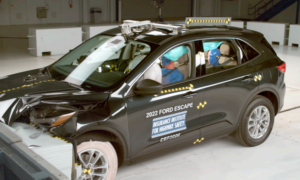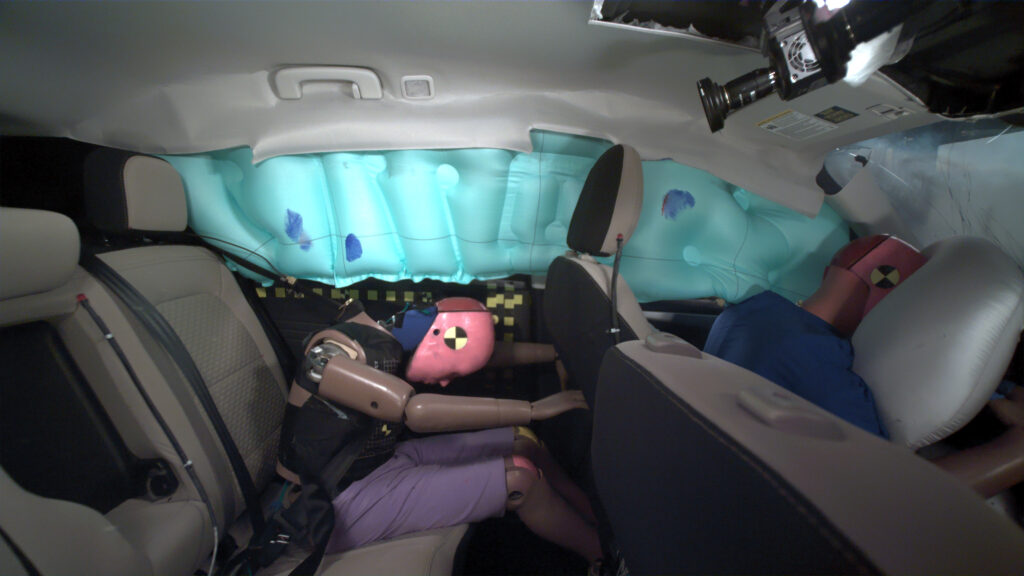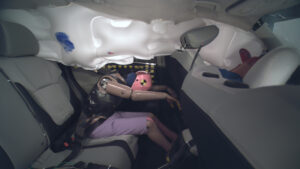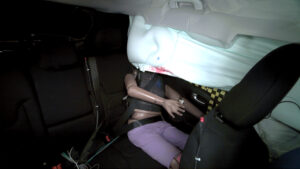
Ford Escape, Volvo XC40 fare best in new IIHS frontal crash test
By onTechnology
The Insurance Institute for Highway Safety (IIHS) is working on updates to its longest-running crash test, the moderate overlap front evaluation and so far, only two out of 15 small SUVs, the Ford Escape and Volvo XC40, protect the rear occupant well enough to earn a good rating.
The testing updates are being done “to address a growing gap in the protection provided for front and rear occupants,” IIHS said.
The Toyota RAV4 earned an acceptable rating while the Audi Q3, Nissan Rogue, and Subaru Forester reached a marginal rating. The other nine vehicles — the Buick Encore, Chevrolet Equinox, Honda CR-V, Honda HR-V, Hyundai Tucson, Jeep Compass, Jeep Renegade, Mazda CX-5, and Mitsubishi Eclipse Cross — rated poor.
“The original moderate overlap test was our first evaluation and the lynchpin of the Institute’s crash testing program,” said IIHS President David Harkey, in a news release. “Thanks to automakers’ improvements, drivers in most vehicles are nearly 50% less likely to be killed in a frontal crash today than they were 25 years ago. Our updated test is a challenge to manufacturers to bring those same benefits to the back seat. The stellar performance of the Escape and XC40 shows it’s possible.”
All 15 vehicles earn good ratings in the original evaluation with “robust” structures and effective restraints that protect the driver’s head from contacting the hard surfaces of the interior and minimize the risk of other types of injuries, IIHS said. “However, the additional measurements provided by the new test show that most of them don’t provide adequate protection for the rear passenger’s head and neck — the most vulnerable areas of the body.”
In the original moderate overlap frontal test, a vehicle travels at 40 mph toward a barrier with a deformable face made of aluminum honeycomb. A Hybrid III dummy representing an average-size man is positioned in the driver’s seat. Forty percent of the total width of the vehicle strikes the barrier on the driver side. The forces in the test are similar to those that would result from a frontal offset crash between two vehicles of the same weight, each going just under 40 mph.
The original test was launched in 1995 and, at that time, most vehicles were rated poor or marginal. Today, all vehicles earn good ratings but IIHS believes there’s further work to be done. A recent IIHS study of real-world crashes showed that in many cases, back-seat passengers were injured more severely than front-seat occupants.
“Not long ago, passengers seated in the rear were substantially less likely to be killed in a frontal offset crash than the driver or front-seat passenger because the biggest factor in survival was the crumpling of the front of the occupant compartment,” IIHS said. “Now, though, there is barely any deformation of the occupant compartment in the moderate overlap test. In addition, automakers have added airbags and advanced seat belts in the front seats but not often in the rear. As a result, in vehicles from model year 2007 onward, the risk of a fatal injury is 46% higher for belted occupants in the rear seat than in the front.”
IIHS’ new test incorporates a second Hybrid III dummy representing a small woman or 12-year-old child positioned in the second row behind the driver and uses new metrics that focus on the injuries most frequently seen in rear-seat occupants.
“We’re excited to launch the first frontal crash test in the U.S. to include a rear-occupant dummy,” said IIHS Senior Research Engineer Marcy Edwards, who led the development of the new evaluation. “This is a fantastic opportunity to rapidly deliver big safety benefits by adapting technologies that we already know to be effective.”
For example, in the front seat, crash tensioners tighten the seat belts the instant a crash begins so that the occupant’s body begins to slow with the vehicle. Then, as the tightened belt stops the occupant from flying forward, force limiters allow some of the webbing to spool out to reduce the risk of chest injuries, IIHS explained.
“Rear-seat occupants would also benefit from these technologies. Features like rear seat airbags and seat belts that themselves inflate to mitigate the effects of crash forces could help too. But less than half of new vehicles have advanced restraint systems in the rear seat.”
The test speed, offset and barrier used in the new test remains the same as those used in the original test. Vehicles still receive ratings of good, acceptable, marginal, or poor but they have to meet several new requirements along with the earlier ones.
To earn a good rating, measurements recorded by sensors in the second-row dummy must not exceed limits that indicate an excessive risk of injury to the head, neck, chest, abdomen, or thigh. Video footage and greasepaint applied to the dummy’s head must confirm that the restraints prevented the head from hitting the vehicle interior or coming too close to the front seatback and also prevented the dummy’s body from “submarining,” or sliding forward beneath the lap belt, which causes abdominal injuries. A pressure sensor that monitors the position of the shoulder belt on the torso of the dummy is being used for the first time to help gauge the risk of chest injuries.
“In real-world crashes, chest injuries are the most common serious rear-seat injuries for adults, so that’s a key focus,” said Research Engineer Sushant Jagtap, who assisted in the development of the new test.
As expected, the occupant compartments of all 15 small SUVs held up well, and measurements taken from the driver dummies indicated a minimal risk of injuries in all but the Equinox, which showed a slightly elevated risk of injury to the driver’s right foot, IIHS said.
The good-rated Escape and XC40 also showed minimal risk of any of those injuries for the second-row passenger. There was also no excessive force on the dummy’s chest or misalignment of the safety belt shoulder strap and no submarining under the lap belt or malfunctioning of the side curtain airbag. However, in the Escape, the rear dummy’s head came closer to the front seatback than is desirable. The rating for the Escape applies to vehicles built after May 2022, when Ford made adjustments to the rear seat belts.
Measurements taken from the head, neck, chest, and lower extremities of the rear dummy also showed minimal risks of injuries to those areas in the acceptable-rated RAV4. However, the second-row dummy’s lap belt moved from the ideal position on the pelvis into the abdomen, increasing the risk of abdominal injuries. The rear passenger dummy’s head also dipped beneath the side curtain airbag during the crash and popped up between the airbag and window on rebound.
Among the three marginal-rated vehicles, injury measures taken from the second-row dummy indicated elevated risks of head and neck injuries in the Q3 and Rogue and a high risk of chest injuries in the Forester. The rear passenger dummy’s lap belt slipped from the pelvis onto the abdomen in the Q3 and Rogue, and in all three vehicles the rear dummy’s head came too close to the front seatback during the crash.
In all nine poor-rated vehicles, injury measurements indicated high risks of head, neck, and chest injuries for the rear passenger and the seat belt exerted excessive force on the chest of the second-row dummy. In the CR-V and CX-5, the position of the rear dummy’s shoulder belt was also very high, which can make the restraint system less effective.
In the Eclipse Cross, Encore, and Tucson, the rear passenger dummy came close to making contact with the front seatback while in the Encore, Renegade, and Tucson, the rear passenger dummy’s head ended up between the side curtain airbag and the window following the initial impact. In the Renegade, this allowed the rear dummy’s head to make hard contact with the C-pillar that connects the vehicle body with the roof behind the rear window.
In the CX-5 and HR-V, submarining by the rear passenger dummy caused the lap belt to slip from the pelvis to the abdomen, increasing the chances of abdominal injuries.
IIHS is also running tests on its crash test systems to prepare for if, and when, more electric vehicles are on the road, IIHS Vehicle Research Center Vice President Raul Arbelaez said.
The center added heavy steel plates and concrete blocks to add 9,500 pounds onto a junker F-150 to see if the propulsion system used in testing could tow a vehicle of that weight, such as EVs. The weight is more than the heaviest vehicle IIHS has ever tested, Arbelaez said.
“We want to make sure it can do it smoothly and maintain that accurate test speed,” he said. “This crash machine has had no issues conducting tests for over 20 years. With electric vehicles coming in and that battery weight pushing vehicle mass higher and higher, we wanted to make sure that if and when those vehicles come to market, and some of them already are, we want to be able to know that we can conduct the test here.”
The target speed for frontal, small, and overlap crashes on both sides of vehicles is 40 mph. The test proved the system successful in its ability to tow a vehicle in at that speed for the frontal crash.
Images
Featured image: The updated IIHS moderate overlap test is the first frontal crash test in the U.S. to include a dummy in the rear seat. (Credit: IIHS)
The rear passenger dummy’s head approached the front seatback in the 2022 Ford Escape, which increases the risk of head injuries. The rating also applies to 2022-23 models. (Credit: IIHS)
Rear passenger dummy injury values indicate a low risk of injury to the head, neck, and chest in the 2021 Volvo XC40. The rating also applies to 2022-23 models. (Credit: IIHS)
The rear passenger dummy’s head approached the front seatback, which increases the risk of head injuries in the 2021 Subaru Forester. The rating also applies to 2022-23 models. (Credit: IIHS)
The rear passenger dummy’s lap belt remained in the ideal position on the pelvis in the 2021 Jeep Renegade. The rating also applies to 2022-23 models. (Credit: IIHS)




